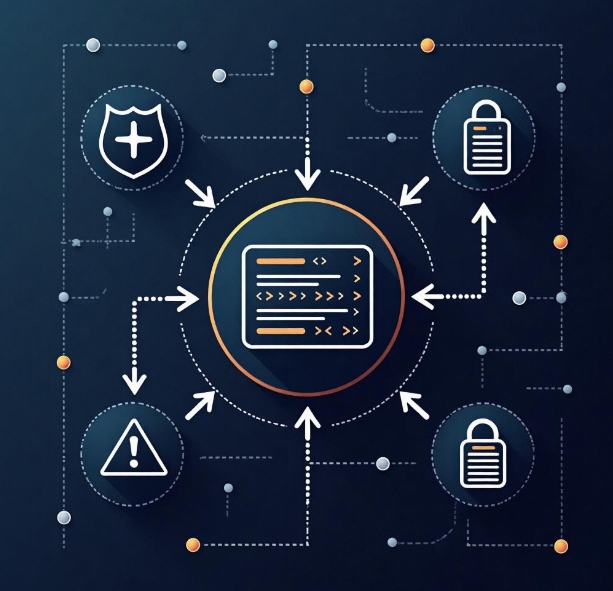Smart Contract Auditing and Vulnerability Detection in DApp Development
- latest articles
- 1.DApp Development & Customization: Merging Diverse Market Needs with User Experience 2.Analysis of the Core Technical System in DApp Project Development 3.How to achieve cross-chain interoperability in Web3 projects? 4.How does the tokenization of points reconstruct the e-commerce ecosystem? 5.How to Set and Track Data Metrics for a Points Mall? 6.What is DApp Development? Core Concepts and Technical Analysis 7.Inventory of commonly used Web3 development tools and usage tips 8.Development of a Distribution System Integrated with Social E-commerce 9.Six Key Steps for Businesses to Build a Points Mall System 10.What is DApp Development? A Comprehensive Guide from Concept to Implementation
- Popular Articles
- 1.Future Trends and Technology Predictions for APP Development in 2025 2.Analysis of the DeFi Ecosystem: How Developers Can Participate in Decentralized Finance Innovation 3.From Zero to One: How PI Mall Revolutionizes the Traditional E-commerce Model 4.DAPP Development | Best Practices for Professional Customization and Rapid Launch 5.Recommended by the Web3 developer community: the most noteworthy forums and resources 6.From Cloud Computing to Computing Power Leasing: Building a Flexible and Scalable Computing Resource Platform 7.How to Develop a Successful Douyin Mini Program: Technical Architecture and Best Practices 8.Shared Bike System APP: The Convenient Choice in the Era of Smart Travel 9.How to Create a Successful Dating App: From Needs Analysis to User Experience Design 10.From Design to Development: The Complete Process of Bringing an APP Idea to Life
With the rapid development of blockchain technology, decentralized applications (DApps) have gradually emerged as a new form of application. DApps rely on smart contracts to achieve automated, transparent, and trustless functionalities. Smart contracts are not only a core component of blockchain applications but also the foundation for DApp operations. However, the complexity and immutability of smart contracts make their security particularly crucial. A single vulnerability can lead to the loss of millions of dollars in assets and even undermine trust in the entire blockchain ecosystem. Therefore, smart contract auditing and vulnerability detection have become indispensable parts of the DApp development process.
This article will explore in detail the necessity of smart contract auditing, common types of vulnerabilities, tools and methods for vulnerability detection, and how to enhance the security of smart contracts to ensure the stability and safety of DApps.
I. Basic Concepts and Importance of Smart Contracts
A smart contract refers to a self-executing contract where the terms of the agreement are written into code and automatically executed and verified by the blockchain network. Unlike traditional contracts, smart contracts do not rely on intermediaries; instead, they leverage the decentralized nature of blockchain and cryptographic algorithms to ensure tamper-proof and transparent execution.
In DApps, smart contracts are typically used to handle transactions, data validation, and automated tasks. Users can perform various decentralized operations by interacting with smart contracts. For example, in decentralized finance (DeFi) applications, smart contracts may be used to implement functions such as lending, trading, and profit distribution.
The security of smart contracts is critical to the success of DApps. Any vulnerability in the code can be exploited by malicious attackers, leading to significant financial losses or data breaches. Therefore, auditing and vulnerability detection of smart contracts are essential steps in the development process that cannot be overlooked.
II. Common Types of Smart Contract Vulnerabilities
Vulnerabilities in smart contracts can arise from various causes, including code defects, logical flaws, and improper contract design. Below are some of the most common types of vulnerabilities in smart contracts:
1. Reentrancy Attack
Reentrancy attacks are one of the most well-known smart contract vulnerabilities, typically occurring when a contract calls an external contract. Attackers can exploit this vulnerability to repeatedly call a specific function in the contract until the contract state becomes inconsistent. For example, the 2016 DAO attack exploited a reentrancy vulnerability, resulting in losses exceeding $50 million.
2. Integer Overflow and Underflow
Since smart contracts often use fixed-size integer types for calculations, integer overflow or underflow can easily occur. For instance, when a variable's value increases beyond its maximum limit, an overflow may occur, causing the result to become a negative number or another unexpected value. Although modern smart contract development frameworks (such as Solidity) have introduced security libraries to mitigate this issue, it remains a potential risk.
3. Timestamp Dependence
Some smart contracts may rely on block timestamps for certain operations, such as voting or auctions. If the contract design is flawed, attackers could manipulate the timestamp by controlling the behavior of block producers, thereby influencing the contract's execution. To avoid such vulnerabilities, developers should refrain from relying on timestamps for critical operations.
4. Access Control Vulnerabilities
Access control is fundamental to smart contract security. If access control in a contract is not stringent, attackers may gain unauthorized permissions and perform actions they should not be allowed to execute. For example, if a contract's administrator permissions are not properly configured, attackers might be able to alter the contract state or withdraw funds.
5. Unsafe External Calls
Smart contracts often need to interact with other external contracts, which may perform unforeseen operations. If an external contract is insecure or its behavior is uncontrollable, the security of the smart contract could be compromised. Therefore, ensuring the security and reliability of interactions with external contracts is a critical task in smart contract development.
6. Contract Upgradeability Issues
Many DApp smart contracts require upgrades, but if the upgrade process is poorly designed, it could be exploited by malicious attackers. Particularly, if the proxy pattern is not implemented correctly, it may lead to the state of the proxy contract being tampered with, thereby affecting the security of the entire application.
III. The Necessity of Smart Contract Auditing and Vulnerability Detection
Once a smart contract is deployed on the blockchain network, it cannot be modified. Therefore, before the contract is released, rigorous auditing and vulnerability detection must be conducted to ensure it has no major security flaws. Security auditing of smart contracts is primarily performed through static analysis and dynamic analysis.
1. Static Analysis
Static analysis involves statically inspecting the smart contract code to identify potential vulnerabilities and security issues through automated tools or manual review. Static analysis tools can detect syntax errors, common vulnerabilities (such as reentrancy attacks and integer overflows), security risks, and poor programming practices in the code.
Common static analysis tools include:
MythX: An automated smart contract security analysis platform that supports static analysis of Solidity code.
Slither: A static analysis tool that can identify common vulnerabilities in smart contracts and provide detailed reports.
Solium: A Solidity code style checker that also performs security checks.
The advantage of static analysis is that it can identify potential security issues before the contract is released, allowing for timely fixes and reducing post-deployment risks.
2. Dynamic Analysis
Dynamic analysis, on the other hand, involves deploying the contract to a test network and conducting real-time security detection by simulating the actual runtime environment. Dynamic analysis can check the contract's security in real-world scenarios by executing test cases and simulating attack scenarios. Common dynamic analysis tools include:
Echidna: A fuzzing tool for smart contracts that can discover vulnerabilities by randomly generating test cases.
Oyente: A dynamic analysis tool for Ethereum smart contracts that can detect issues such as reentrancy attacks and overflows.
Dynamic analysis can uncover potential security issues during actual operation that may not be detected during the static analysis phase.
3. Auditing Teams and Security Research
In addition to automated tool detection, smart contract security auditing requires professional auditing teams. These teams typically conduct in-depth analyses of the contract's logic, code structure, and attack surfaces to ensure the contract's security in real-world operation. There are many professional smart contract auditing companies in the market, such as CertiK, Trail of Bits, and ConsenSys Diligence, which provide detailed audit reports to developers through a combination of manual review and automated tools.
IV. How to Improve Smart Contract Security
Although smart contract auditing and vulnerability detection can significantly reduce security risks, developers still need to fundamentally enhance the security of their contracts. Here are some recommendations for improving smart contract security:
1. Write Simple and Clear Code
Smart contract code should be as simple and clear as possible, avoiding overly complex logic. Complex code is more prone to vulnerabilities and also increases the difficulty of auditing. Developers should follow best programming practices and avoid unnecessary complexity.
2. Use Mature Libraries and Frameworks
During smart contract development, it is advisable to use mature, security-audited libraries and frameworks, such as the contract libraries provided by OpenZeppelin. The OpenZeppelin library includes a wide range of rigorously audited standard contracts, such as token contracts and access management contracts, which can help developers reduce the risk of vulnerabilities.
3. Contract Testing and Simulated Attacks
After completing contract development, developers should conduct thorough testing through unit tests, integration tests, and other methods. Additionally, simulated attacks, such as reentrancy attacks and DoS attacks, can be performed to ensure the contract responds correctly under attack.
4. Conduct Multiple Rounds of Auditing
Smart contracts should undergo multiple rounds of auditing, not relying solely on a single auditing team or tool. Multiple audits and tests can uncover potential issues from different perspectives, reducing the risk of vulnerabilities.
5. Design for Upgradability Before Deployment
For DApps that require long-term maintenance, developers can consider using upgradable contract designs, such as the proxy pattern, to allow timely upgrades in case of vulnerabilities without the need for complete redeployment.
V. Conclusion
With the widespread adoption of DApps, the security of smart contracts, as their core component, has garnered increasing attention. Vulnerabilities in smart contracts can not only lead to financial losses but also undermine the trust foundation of the blockchain ecosystem. Therefore, auditing and vulnerability detection of smart contracts are of paramount importance.
-

DApp Development & Customization: Merging Diverse Market Needs with User Experience
As blockchain technology matures and becomes more widespread, decentralized appl···
-

Analysis of the Core Technical System in DApp Project Development
With the rapid development of blockchain technology, decentralized applications ···
-

What is DApp Development? Core Concepts and Technical Analysis
With the rapid development of blockchain technology, decentralized applications ···

 Blockchain
Blockchain












